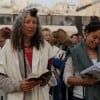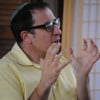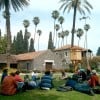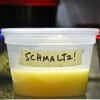Recent staff changes (in alphabetical order!): Mark Bailey came on board in June as our new Design Fellow (in the Marketing & Communications branch) Judith Belasco is now Hazon’s Chief Program Officer Julie Botnick shifted to the position of Program Associate on August 3rd. Jac Cohn has re-joined the Hazon family as our Adamah Marketing Apprentice. Drisana Davis and Nia Taylor will be leaving Hazon as of October 31, as we undertake a Bay Area transition and de-staffing. Jessie Katz is currently shifting to the new position of Director of Outreach, moving over to this new role full-time after the NY Ride. Among her responsibilities, Jessie will staff a New York Regional Advisory Board. Miriam Leichtling has been hired as our new Director of Rides, beginning August 11th. Meredith Levick has been hired for the new role of Associate Director of Education) and began work on August 3rd. Becca Linden, while not changing titles, will be shifting a significant amount of her focus towards leading our new Hazon Seal of Sustainability program. Nati Passow left Hazon as of July 31st to focus on Jewish Farm School, with Leah Lazer becoming lead staff person in the Philadelphia region; David Rendsburg is […]
Author Archive | Nigel Savage

Hazon in the Bay Area…
I’m writing to Hazon stakeholders in the Bay Area to thank you for your support in the past and to let you know about the next evolution of our work here. Our work here began when I was in San Francisco in September 2001, hoping to launch Hazon events in the Bay Area. My meeting with key leaders in the Jewish community was scheduled for 10am… on the day of 9/11. That meeting became a footnote to a very different sort of day than the one we were expecting. But the determination to build what came to be known as Jewish Outdoor, Food & Environmental Education (JOFEE, for short) remained with me and with Hazon. In 2008, backed by the Richard and Rhoda Goldman Fund, we started our first regional office in the Bay Area. Our goal was to start to renew Jewish life, and to create a more sustainable world for all. We started off by moving the multi-day Hazon Food Conference from Isabella Freedman Jewish Retreat Center in Falls Village, CT to Northern California. In total, more than 1,500 people came to the Food Conference over the next three years. It laid the groundwork for the last seven years […]

Three Gifts from Jewish Tradition
Nigel Savage’s address at the Summit of Conscience for the Climate, Paris, 21st July 2015 | 5th Av 5775 Friends, I’m honored to be here, part of this incredible group of people. This has been a fascinating, inspiring, thought-provoking day. I want to say a personal thank you to Cardinal Turkson, and through you to His Holiness the Pope. I think I am not the only Jew who feels that this Pope speaks for me. I hope you will take this as a compliment if I say that he is not only an extraordinary Pope and a wonderful man, but in my language a great rabbi, and even a tzadik. Thank you so much to you and to him for inspiring us and challenging us and for modeling what is possible. I’m here today because for 15 years I’ve been leading an organization called Hazon, Hebrew for vision. We’re working within and beyond the Jewish community to create a healthier and more sustainable world for all. You could argue, of course, that the Jewish people have been thinking about sustainable energy ever since God spoke to Moses out of a bush that was burning but never consumed. Moses might have […]

Bonna Devora Haberman, z”l
I first met Bonna in London in late 1985. She and Shmuel and Tiferet were living on the attic floor of an old house in Hampstead while she finished her Phd. I had never met a couple like Bonna and Shmuel before. They moved to their own beat. They were quirky, charming, funny, eclectic. I couldn’t locate them on any axis of people I had met before in my life. In February, 1986, they invited me to a Tu B’shvat seder in their flat. Gilah and Mickey Rosen (z”l) were there, and Sammy Barth, and someone from the American Embassy. There was a huge long haggadah that they had written, somehow printed in English and Hebrew and Rashi script from a computer (I had never seen that before, either). I didn’t understand half of it but it is a measure of Bonna and Shmuel’s impact on me that I have hosted or attended a Tu B’shvat seder in every year since. I told Bonna when I last saw her, just a few weeks ago, that this year was indeed my 30th consecutive seder since her first one. And just as they introduced me to Tu B’shvat, so too they introduced […]

2022 Vision / The Pope on Yom Kippur
I’m here at Isabella Freedman, learning about shmita with a group of Israelis and Americans, and noting in relation to shmita that the next few months has an interesting conjunction of events. Next Thursday sees the release of Laudato Sii (“Praised Be To You”), Pope Francis’s first encyclical. We don’t know what he will say; but the presumption is that he will bring to bear his distinctive voice, and his very considerable moral authority, on two closely related topics: how we treat this planet; and the consequences of how we treat this planet on poor and vulnerable people around the world. And meantime, the shmita year is drawing towards its close; this Rosh Hashanah will mark the start of a new 7-year cycle in Jewish life. When I first started thinking about shmita, in late 2007, I thought that we would spend several years preparing for the shmita year. Only a year or so ago, as the start of the shmita year came clearly into view, did I understand for the first time that the opposite is also true: the shmita year is a time to step back and reflect on the last six years, and to imagine and vision […]

Oral Torah of a different sort…
Facilitation 501: How to construct and deliver a panel The Lippman Kanfer Foundation for Living Torah are supporting Hazon (and, I think, some other organizations) in our “oral Torah” project – helping us to harvest some of our accrued wisdom over these last fifteen years. It’s a fascinating process, reflecting on some of the things that we feel we have learned or do well, and starting to codify them. Most of this is focused on framing Jewish tradition: how, and why, and in what ways, we draw connections between Jewish tradition and the world that we live in today. Allowing Jewish tradition out of the small boxes we sometimes place it in. But marinating in Jewish tradition like this – allowing it out, as it were, to roam more widely – also can and should enable us to see aspects of contemporary life with a Jewish sensibility also. And so it is, therefore, that I offer you today a very different kind of “oral Torah.” I have earned it and learned it slowly, by trial and error, over 20 years. It consists in ten rules to help you construct, produce and deliver superb panels at conferences and events. At our […]

Birthdays
It is by the grace of many people reading this email that Hazon exists. Though I do not say it specifically in every email, I want those of you who support Hazon – individual supporters; foundation staffers; federation donors; board members; staff members – to know that I think about this each day. A non-profit is a trust, in which many people come together, loosely and in all sorts of different ways, in order to accomplish something in the world – to touch people’s lives, to bring new ideas to fruition, to shift the nature of what it means to be Jewish or American or Israeli, to help us live more carefully on this our only planet. In leading Hazon I’m aware of both the fragility and the potential durability of a non-profit, as a vessel for the hopes and the visions of so many. I gave a donation for Manchester Grammar’s 500th anniversary this year: my school survived the English Civil War unscathed, even though the English monarchy did not. I don’t know if the USA will exist in 2136, but I imagine that Harvard, which is due to celebrate its 500th birthday that year, and which has an […]

Four Questions For Your Second Night Seder
I’m writing in Israel, following a rather remarkable tour of “kehillot mesimatiot” – a newish phrase that literally means something like “mission-driven communities” and which maps, more or less, to the English “Intentional Communities.” It includes a variety of experiments in urban communal living and social change: some of them sharing all their money and some not; some living together and some not. But all of them living in participatory and democratic communities, with an explicit commitment to making the world around them better. We met diaspora 20-somethings who’ve made aliyah and are living in urban kvutzot – groups – in Haifa. We went to Beit Jann to see a Druze community doing remarkable leadership work with teens. We stayed with garinim toraniim, religious groups, in Akko, Bet Shemesh and Lod. In Afula we met the founders and leaders of Tarbut – an artist’s kibbutz of approaching 100 people, who have spawned a youth movement, and developed a queer nightclub scene in the town. In Nazareth Illit we were with Kibbutz Mishol, the largest of the modern urban kibbutzim, co-founded by James Grant-Rosenhead. In Akko we helped the garin there pack pre-pesach food boxes for local people – both Jewish […]

This week in Israel
On our Israel Ride we often cycle to Ein Karem. But this week, for the first time, I visited Kaima Farm, in Beit Zayit, just on the other side of the hill. It was founded by Yoni Refet Reich, a recovering lawyer who is both practical and inspiring. He and a group of friends have created an organic farm that’s run by at-risk teenagers – kids who have been in trouble in all sorts of ways. The kids are actively involved in all decision-making. They are paid for their work, and they’re expected to be there by 7am in the morning – which they are. Many hundreds of volunteers helped to clear the fields of stones. They have a great record of their participants getting clean and getting back into education. They sell the food they grow in a CSA that generates a significant part of their revenue. Very inspiring. We went to the Heschel Center’s new Sustainability Center in Gilo, a neighborhood of Jerusalem in which locals are steadily cleaning up the neighborhood – quite literally. As they do so they’re making it more sustainable, in all sorts of ways, and they’re significantly strengthening relationships amongst neighbors. I met […]

From Purim to Pesach
I think of the period from seder night until Shavuot as a sustained reflection on the nature of freedom, and in particular about traveling from freedom from (want, oppression, slavery) to freedom to (make a difference in the world, exercise choice, restrain oneself in certain ways.) The period from Purim to seder night is thus preparation for this. It’s the work we need to do to be able to start to leave our own enslavement and to think freshly and confidently about our freedom. And the tradition’s great insight – hidden in plain view – is that a significant part of that process is about getting rid of stuff. Certainly this involves removing chametz, traditionally understood – bread and beer and whisky and other fermented products. But the deeper gift of this period – certainly in our time, certainly in the west – is the deeper notion that we have too much stuff of all sorts, and that if we truly want to be free – if we want even to begin to imagine our true freedom – the road to doing so involves getting rid not only of literal chametz but of existential chametz – the superfluities that hinder […]

Leadership & Followership: Support Your Local Rabbi….
I continue to be struck that the Jewish community spends a lot of time talking about “leadership” and almost none teaching about what we ought to call “followership.” Part of my understanding of this derives from my reading of a famous line in Pirkei Avot, one of the oldest and most famous parts of the Mishnah: “aseh l’cha rav” – עֲשֵׂה לְךָ רַב – make someone your rabbi; “u’knei l’cha chaver” – וּקְנֵה לְךָ חָבֵר – and acquire a friend; “v’hevei dan et kol ha’adam l’chaf zechut” – וֶהֱוֵי דָן אֶת כָּל הָאָדָם לְכַף זְכוּת – and give every person the benefit of the doubt. Some damage has been done to Jewish life by simply gluing Jewish teachings to contemporary liberalism. I’m less interested in where Jewish teachings coincide with what I know already than where they dissent. This teaching is for me one of the most striking, one of the most interesting and one of the most useful such instances. The heart of how I read this verbal triptych starts with thinking about the curious use of the verb “k’nei” – קְנֵה – acquire. We would not normally say to someone, “go out and buy yourself a friend:” that […]

Greening Efforts Strengthening Jewish Life, Identity, and Institutions
During this last seven-year shmita cycle, UJA-Federation of New York has invested nearly $2 million in Hazon’s Jewish Greening Fellowship. It was brought into existence by Adam Berman and Rabbi Deborah Joselow and it has been very ably led, in succession, by Rachel Jacoby-Rosenfeld, Dr. Mirele Goldsmith and now Becca Linden. This week’s Leading Green gathering at UJA-Federation of New York was a moment simply to note how much has been accomplished. JGF organizations have raised roughly $3.6 million from mostly state and local sources for green improvements and programs, and they will save – at minimum – at least $2 million over the next decade through increased energy efficiency and reduced waste. So just in financial terms, the program has been remarkably successful, at a time of significant financial stress across Jewish non-profits. But the financial impact is only a part of it: 70 Fellows at 55 organizations have participated in leadership training, intensive workshops, and field trips that have enabled them to green their institutions and communicate how Jewish values are informing our response to this central challenge of our time. More than 600 people have participated in Green Teams, roughly 33,000 have participated in educational programs, and […]

Secular Jews and Secular Jewish Culture
Where does secular Jewish culture come from? Can or should we try to preserve it? Someone wrote to me about last week’s email to say that I was disrespecting “the secular Jewish community.” I replied that I didn’t think that I was, and I certainly didn’t intend to; but the correspondence (and, perhaps ironically, one or two things in this week’s parsha) prompted me to reflect on the nature of contemporary Jewish secularity. It’s an important conversation, and one that, for me, began almost thirty years ago at lunch with Felix Posen in a sushi restaurant in London’s West End. Felix thought you could educate for secular Jewish culture. I was – and remain – skeptical. Yet this skepticism is not the end of the story. I want to note that when we talk about “secular Jewish community” we actually mean two quite distinct things. One is at the level of theology – people who “don’t believe in G!d.” The other is really about Jewish culture – a sense of Jewish culture deriving from Jewish tradition but independent of, for instance, synagogue or services. These two kinds of secularity are quite distinct. There are many observant (ie “religious”) Jews who, […]

Schmaltz, Pastrami and Sushi: Now What?
Beinart at Bloom’s… Sometimes if I’m talking about the Jewish Food Movement I’ll say to an audience “put your hands in the air if you grew up with schmaltz in the fridge.” 90% of anyone 70 or over puts their hands in the air. Then I’ll say, “put your hands up if you have schmaltz in the fridge now.” If there are a hundred people in the audience, maybe two hands might go up. More recently – seeing quizzical faces – I added “put your hands up if you don’t know what schmaltz is.” A bunch of hands go up in the air – all of them amongst the younger people in the room. That’s the backdrop to Peter Beinart’s piece in Ha’Aretz, yesterday, copied here in full, because it sums up so clearly something I’ve been thinking about recently: I realized the other day that my two children, ages nine and six, have never tasted pastrami. In fact, I’m not even sure they know what it is. They’ve never tasted chopped liver or herring either. They’re unfamiliar with Dr. Brown’s Soda, and they feel no particularly affinity for rye bread. Were they growing up in Bismarck, North Dakota, this […]

Tza’aka, 2015, the World Zionist Congress, and Goodbye to Cheryl…
I have been thinking, recently, about tza’aka – crying out. It is the motif in the Torah for the moment when a person or a people says: enough is enough. After twenty quiescent generations of slavery, it is the tza’aka of the children of Israel which signals that something is about to change – that freedom is about to be within our grasp. And this is not just in the Torah. It was a kind of tza’aka that brought the Civil Rights movement in this country. It was a tza’aka that brought down the Berlin Wall. The Climate Change march in New York just before Rosh Hashanah was a tza’aka, and it helped to nudge the US and other governments in the direction of a substantive climate treaty. And what happened in Paris and in France on Sunday, provoked and inspired by tragedy, was a very glorious moment of tza’aka. Less than four weeks ago I was writing about fissures in our community, partly provoked by having just been in Paris. Here’s what I wrote then. I ended, inter alia, with “May we never need to defend ourselves – but may we have the courage and the confidence to do […]



